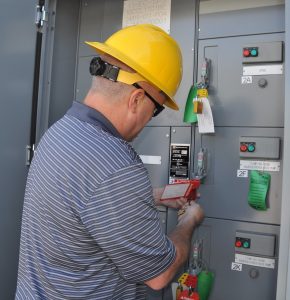35 Lock-Out / Tag-Out
Learning Objectives
Explain the process of lock-out / tag-out.
What is Lock Out/Tag Out?
Definition
It requires that hazardous energy sources be “isolated and rendered inoperative” before work is started on the equipment in question. Lockout–tagout is used across industries as a safe method of working on hazardous equipment.
Applying lockouts during maintenance is intended to avoid accidental energy release, whereas tagging them out keeps employees aware of what is going on with the machine. In spite of regulations, serious accidents continue to occur due to lapses during lockout and tagout (LOTO) applications
How Does it Work?

Regulations require that all powered machinery or equipment shut down for maintenance or repair must be secured against the possibility of the equipment being accidentally turned on while being worked on. To safeguard the person working on such equipment, lock-out procedures must be posted near the equipment, and the procedures listed must be followed before repairs or maintenance can start.
Locking out a machine usually means the power feeding the machine is disconnected either by pulling a plug, placing a switch in the off position, or turning a circuit breaker to the off position. The disconnected circuit is then secured in the inoperative position by the use of a padlock. The person doing the maintenance or repair keeps the key to this lock until the work on the machine has been completed. The worker then removes the lock and the machine is again operable.
Disconnecting or making safe the equipment involves the removal of all energy sources and is known as isolation. The steps necessary to isolate equipment are often documented in an isolation procedure or a lockout tagout procedure.
The isolation procedure generally includes the following tasks:
- Announce shut off
- Identify the energy sources
- Isolate the energy sources
- Lock and tag the energy sources
- Prove that the equipment isolation is effective
The locking and tagging of the isolation point lets others know not to de-isolate the device. To emphasize the last step above in addition to the others, the entire process can be referred to as lock, tag, and try (that is, trying to turn on the isolated equipment to confirm it has been de-energized and cannot operate).
Depending on the situation, the lock might be used to secure the power switch of the machine, or it might be used to lock shut the door to a circuit breaker panel where the thrown breaker is located.
If the machine is not wired into its own power circuit but simply plugs into the wall, the lock-out procedure may require that the machine be turned off with its power switch and unplugged from the power receptacle. The plug end of the machine must be kept in plain view of the repair person so no one can inadvertently restore power without the repair person’s knowledge.
In industrial processes it can be difficult to establish where the appropriate danger sources might be. For example, a food processing plant may have input and output tanks and high-temperature cleaning systems connected, but not in the same room or area of the factory. It would not be unusual to have to visit several areas of the factory in order to effectively isolate a device for service (the device itself for power, upstream material feeders, downstream feeders and control room).
You must be aware of the lock-out procedures that are to be followed before repairing or cleaning any machine. Lock-out procedures must be clearly posted by management near each machine.
A sample lock-out procedure notice is shown below. As has been stated, this notice would be posted near the machine that must be locked out.
Dough Mixer Lock-Out Procedure
- Shut off mixer at start/stop switch.
- Shut off at disconnect behind mixer.
- Apply lock to disconnect. (Put key in pocket, do not leave key in lock.)
- Attempt to start mixer. (Mixer should not start at this point.)
- Reset or return switch to “off” position.
- Complete work on mixer.
- Ensure bowl and mixer are clear of loose pieces, tools, etc.
- Remove lock.
- Restart mixer and run up to operating speed.
[h5p id=”13″]
Group Lockout

When two or more people are working on the same or different parts of a larger overall system, there must be multiple holes to lock the device. To expand the number of available holes, the lockout device is secured with a folding scissors clamp that has many pairs of padlock holes capable of keeping it closed. Each worker applies their own padlock to the clamp. The locked-out machinery cannot be activated until all workers have removed their padlocks from the clamp.
Lock Out/Tag Out in Canada
All Canadian jurisdictions legally require lockout for certain work. However, the specific activities required for appropriate lockout are usually not specified in law. These specifics are provided through industry standards. The Canadian Standards Association’s standard CSA Z460, based on industry, labor and government consultations, outlines the specific activities of a lockout program and is usually considered the appropriate standard of good practice for lock out. All Canadian health and safety legislation places a general duty on an employer to take all reasonable precautions and carrying out this standard of good practice is usually considered a mark of due diligence.
For additional information on the LOTO process, view this video: https://youtu.be/I2W8vTOOZCc
Sources for this section:
https://www.mdpi.com/2313-576X/5/2/25/htm
https://www.wisc-online.com/learn/technical/industrial-automation/iau19721/the-lockouttagout-procedure
https://en.wikipedia.org/wiki/Lockout–tagout
Sources used included within Wikipedia:
https://www.osha.gov/laws-regs/regulations/standardnumber/1910/1910.147
https://www.osha.gov/laws-regs/regulations/standardnumber/1910/1910.333
https://www.osha.gov/redirect?p_table=STANDARDS&p_id=9868
https://www.osha.gov/control-hazardous-energy
